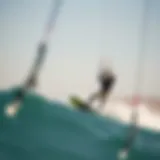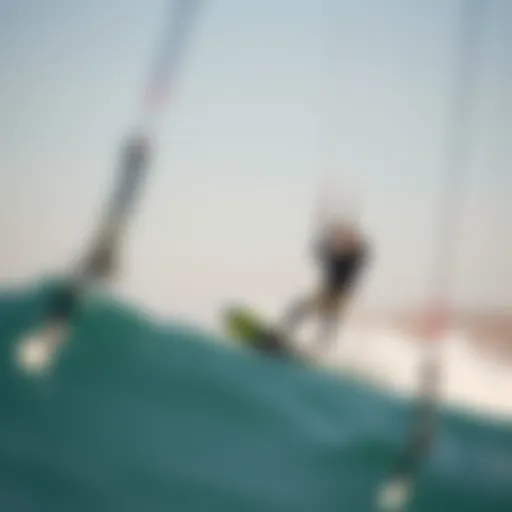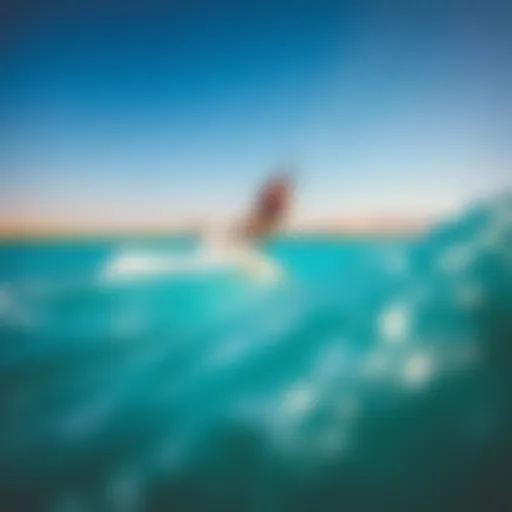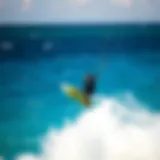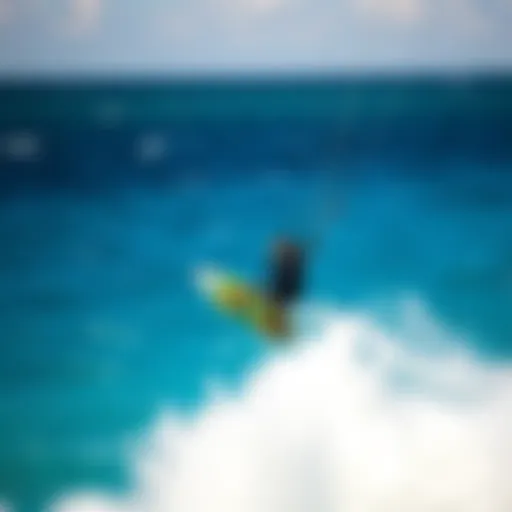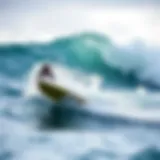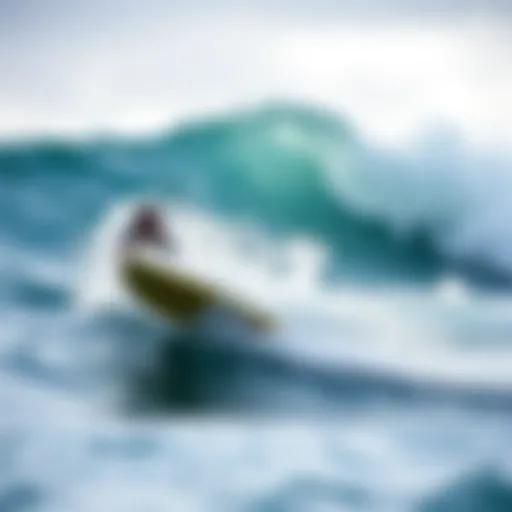Mastering Hydro Wakeboarding: Techniques and Tips
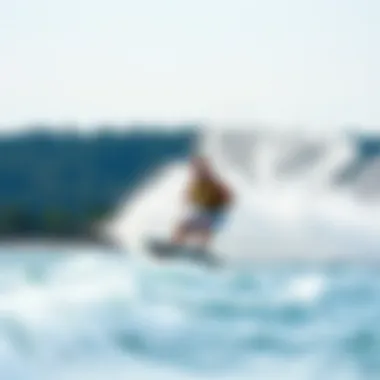
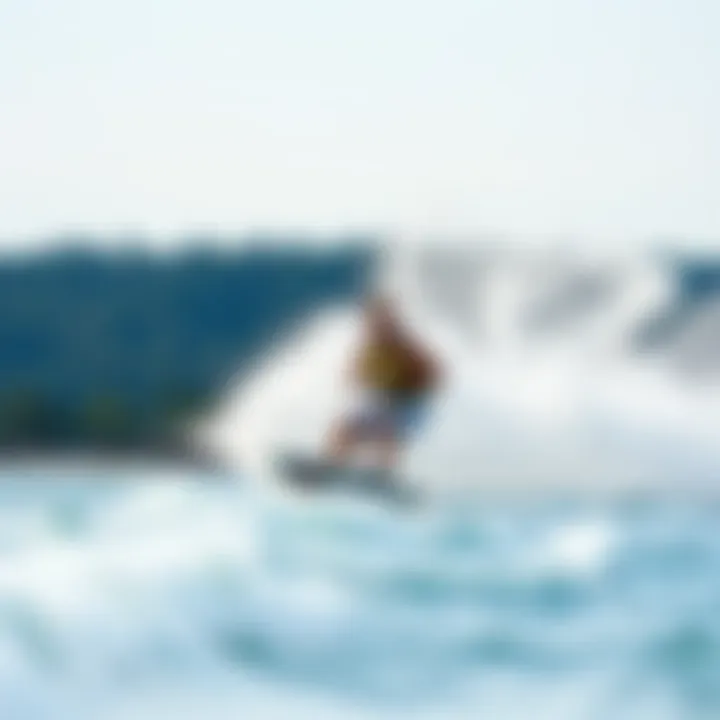
Intro
Hydro wakeboarding, a captivating fusion of speed, balance, and skill, has captured the hearts of water sports enthusiasts around the globe. Emerging as a distinguishable branch of wakeboarding, it employs the innovative use of hydrofoil technology to enhance the riding experience. Whether you're an aspiring wakeboarder looking to learn the ropes or a seasoned pro seeking to expand your skillset, this comprehensive guide will provide valuable insights into the distinct techniques, gear, and community that make hydro wakeboarding a thrilling pursuit.
This article begins with a deep dive into the techniques tailored for both beginners and advanced riders, ensuring that you grasp the essentials of navigating the water with confidence. Following that, we'll review crucial equipment to enhance your hydro wakeboarding experience. Alongside these practical elements, we’ll also touch upon vital safety measures to keep in mind, address environmental considerations of the sport, and explore the community supporting this exhilarating water activity. By the end of this guide, you'll be well-equipped to tackle the waters and enjoy the excitement that hydro wakeboarding brings.
In the next sections, we’ll break down the skills needed for both novice and expert riders, expanding your understanding and appreciation of this dynamic sport.
Prologue to Hydro Wakeboarding
Hydro wakeboarding has carved out a niche in the world of water sports, blending excitement with skill and technique. This discipline focuses on the unique aspect of riding behind a boat while being propelled over water at impressive speeds. Whether you're a seasoned rider or a newcomer to the sport, understanding the foundational elements of hydro wakeboarding sets the stage for enjoyment and safety.
The landscape of water sports changes quickly, and hydro wakeboarding offers a refreshing twist that attracts thrill-seekers and those who appreciate the artistry involved. The fluid dynamics of riding over the water, for instance, distinguish it from traditional wakeboarding, highlighting the unique experiences riders can expect. This section will explore the essence of hydro wakeboarding, from how it's defined to why it's essential in the broader context of water sports.
Defining Hydro Wakeboarding
At its core, hydro wakeboarding is akin to traditional wakeboarding but with a distinct element: the equipment and riding technique allow for a more dynamic interaction with water. Riders utilize specially designed boards, often called hydro boards, that capitalize on hydrofoil technology to lift above the water surface. This breakthrough in design minimizes drag, allowing for higher speeds and smoother rides over the water.
Unlike standard wakeboarding, where maintaining contact with the water is necessary for propulsion and tricks, hydro wakeboarding allows riders to experience the thrill of gliding effortlessly above the surface. The beauty of this sport lies in its versatility; the board design enables fluid movement, making it easier to navigate various water conditions. Additionally, the excitement of performing tricks while skimming the surface creates a unique combination of challenge and fun for participants.
Importance of Hydro Wakeboarding in Water Sports
The significance of hydro wakeboarding within the realm of water sports cannot be overstated. As water sports continue to expand and evolve, hydro wakeboarding represents a fresh avenue for competitors and enthusiasts alike. Here are several aspects highlighting its importance:
- Technological Initialization: Hydro wakeboarding symbolizes the growth of technology in sports, showing how innovation can enhance performance.
- Accessibility: With minimal equipment requirements, it opens doors for beginners who may feel overwhelmed by the complexities of other water sports.
- Community Engagement: Hydro wakeboarding fosters a sense of community among enthusiasts, promoting gatherings, competitions, and social bonds that enhance the sport's overall appeal.
- Skill Development: Not only does it allow for thrilling rides, but it also encourages riders to develop various skills, from balance to aerial tricks, pushing the boundaries of what’s possible.
"Hydro wakeboarding isn't just about the ride. It's about connecting with the water, the equipment, and the community around you. Once you're hooked, it’s hard to let go."
Ultimately, hydro wakeboarding enriches the water sports landscape, inviting a diverse audience to engage with the thrill of riding while highlighting the continuous evolution of outdoor adventures. As riders take to the water, equipped with knowledge about safety practices, technical skills, and environmental consciousness, hydro wakeboarding transforms from merely a sport into a lifestyle.
Historical Context
The historical context surrounding hydro wakeboarding is pivotal in understanding the trajectory and growth of this exhilarating sport. The past informs the present, helping enthusiasts appreciate the nuances of hydro wakeboarding that might otherwise be overlooked. Amidst the ebb and flow of water sports, the lineage of hydro wakeboarding is rich and deserves exploration.
Origins of Wakeboarding
To fully grasp hydro wakeboarding, one must consider the roots of its precursor, wakeboarding. Wakeboarding emerged in the late 1980s and was influenced by various disciplines such as surfing, snowboarding, and skateboarding. The sport was born when riders began to use a wakeboard behind a boat, cutting through water waves in a manner that mimicked the freedom found on solid ground.
This innovation offered a new type of experience for thrill-seekers. Riders strapped themselves onto boards, wanting to catch air off the wake of boats, turning mere speed into an invigorating dance across the water. Notably, the first prototype wakeboard was developed by a surfboard manufacturer, which sheds light on how deeply intertwined these sports are. The transition from traditional surfing to wakeboarding needed pivotal tweaks, particularly in board shape and binding technology, laying the groundwork for future developments, including hydro wakeboarding.
Evolution of Hydro Wakeboarding
As the years rolled on, enthusiasts and inventors looked for ways to enhance the wakeboarding experience. Enter hydro wakeboarding, a variation that combines the thrills of wakeboarding and hydrofoiling. This progression began around the early 2000s, when practitioners experimented with hydrofoils.
Hydrofoils are specialized equipment that elevate the rider above the water, reducing drag and unlocking new avenues for tricks and performance. These boards enable riders to 'fly' just above the surface, giving a sensation reminiscent of surfing on the crest of a wave but with a distinctly different mechanics.
Today, hydro wakeboarding has seen advancements in technology, resulting in designs that optimize stability and performance. The hydro wakeboards are often made from lighter materials, which improves agility and responsiveness on the water. As more riders take to the sport, a culture has formed that values both innovation and tradition, with competitions showcasing the best tricks and techniques.
In summary, the historical development from wakeboarding to hydro wakeboarding is not just a timeline of events; it’s a testament to humanity's perpetual quest for thrill. Understanding this context enriches the experience for all participants, from novices to advanced riders, allowing them to appreciate every aspect of this water sport.
"The history of a sport shapes the passion of its players, and understanding that history can elevate the experience for all involved."
For more information on the evolution of water sports, you can visit Wikipedia or Britannica. Also, check platforms like Reddit for community discussions and personal stories from fellow enthusiasts.
Core Techniques
Mastering core techniques is crucial for anyone looking to thrive in hydro wakeboarding. These techniques not only lay the foundation for safety but also enhance performance, ensuring that riders can enjoy their time on the water to the fullest. Understanding the core techniques provides a pathway to executing maneuvers with finesse while minimizing the risk of injury. A strong grasp of these fundamentals allows both novice and experienced riders to progress, pushing their limits while enjoying the exhilarating rush that hydro wakeboarding delivers.
Basic Maneuvers
Starting off, let’s go over some basic maneuvers essential for beginners. Mastering these movements is like learning to walk before you can run.
- Getting Up: The most common struggle for newcomers. To get up, position your board perpendicular to the water, keep your knees tucked towards your chest, and let the boat pull you up. It’s all about coordination—allow the board to come up with you rather than forcefully standing straight.
- Riding Straight: While it sounds simple, balancing while riding straight can challenge a lot of first-timers. Focus on maintaining a low center of gravity. Lean slightly forward while keeping your arms extended to absorb any bumps from the water.
- Turning: After getting comfortable on the board, turning becomes the next milestone. The trick is to shift your weight gradually. To turn right, shift your weight to your left foot and vice versa; the board will respond accordingly. Practice this in small arcs before attempting sharper turns.
- Stopping: It's essential to know how to stop safely. To do so, bend your knees slightly and begin moving the board in a direction opposite to the boat's pull, which will gradually slow you down until you're at a standstill. This skill is vital in avoiding collisions and ensuring your safety.
By mastering these basic maneuvers, riders build confidence and acquire a better understanding of their board's responsiveness. As they say, "Practice makes perfect."
Advanced Techniques
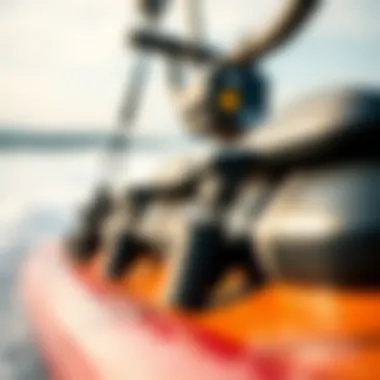
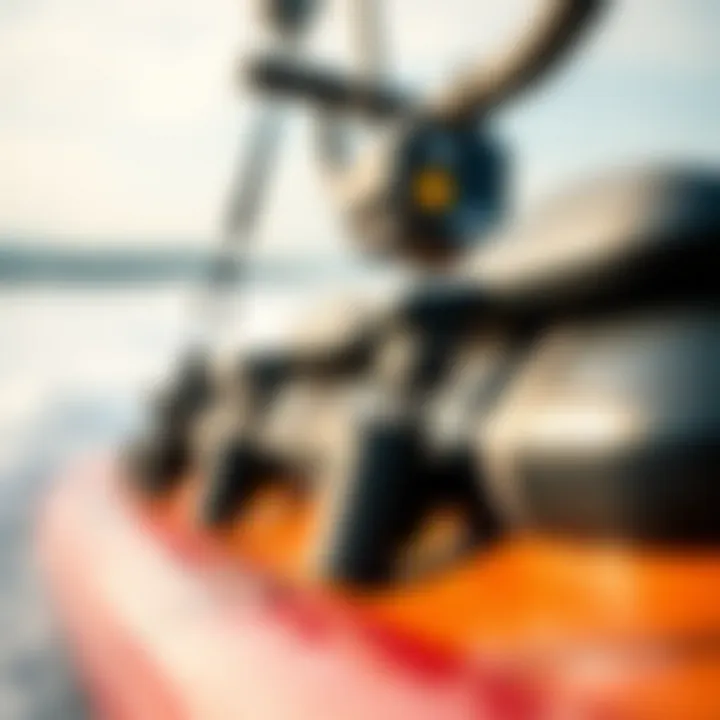
Once you've got the basics down, it’s time to elevate your game with advanced techniques. These techniques allow for creativity and skill enhancement.
- Jumping: This is often the cherry on top for most riders. To perform a jump, generate speed and approach a ramp or wake. As you hit the wake, pop off the board while pulling your knees towards your chest. Timing and landing evenly on both feet is key to a successful landing.
- Spins: A spin can turn heads and really showcase a rider’s skill. Start with a simple 180-degree spin by shifting your weight and looking in the direction you want to go. Progress to more complex spins, like a 360, as your confidence grows.
- Grabs: Grabbing the board while jumping adds style to your moves. Mid-air, reach down and grab the edge of your board with one hand. This might take some practice, so don’t get discouraged if it feels awkward at first.
- Inversions: For those looking to push boundaries, inversions like flips can take your riding to another level. These moves require precise timing and a solid understanding of jumps. Start small and work up to more complex flips with guidance from instructors or experienced riders.
Like increasing the volume on your favorite song, mastering these advanced techniques amplifies your hydro wakeboarding experience. As with any skill, the key is to be patient, maintain focus, and have fun whilst learning.
"The only limit to your impact is your imagination and commitment."
By continually developing these core techniques, riders prepare themselves for a rewarding journey in the thrilling arena of hydro wakeboarding. For more comprehensive resources, consider checking out websites like reddit.com or Britannica for insights from fellow wakeboarders.
Equipment Essentials
Understanding the equipment necessary for hydro wakeboarding plays a vital role in both the enjoyment and safety of the sport. With a specialized approach to gear, riders can improve their performance while minimizing risks associated with water activities. A solid grasp of this subject can make the difference between a pleasant ride and a challenging experience.
Hydro Wakeboards Explained
Hydro wakeboards are specially designed boards that cater to the unique dynamics of hydro wakeboarding. Unlike traditional wakeboards, these are crafted to operate on the surface of the water using the power of hydrofoils. The boards sit lifted above the water, creating an exhilarating sensation of flying while still allowing the rider to carve through waves.
In terms of construction, hydro wakeboards typically feature materials like carbon fiber or fiberglass for strength and lightness. A smooth bottom surface is crucial as it reduces drag, allowing for smoother navigation across the water. Most boards are adjustable for different skill levels; beginners favor wider boards for stability, while experienced riders may opt for narrower and more agile options.
"The right board can amplify your experience and help you ride like a pro."
Bindings and Accessories
The importance of proper bindings cannot be overstated in hydro wakeboarding. The bindings attach the rider to the board, providing both comfort and security. A good pair of bindings should fit snug but not overly tight, allowing for quick adjustments in case of a fall. Many riders prefer bindings with a quick-release mechanism; theswe allow for easy exits during emergencies, which is essential.
In addition to bindings, there are other accessories that enhance safety and performance. Consider adding a towable rope with an appropriate length for hydro wakeboarding — usually between 55 to 75 feet. This ensures an ideal distance from the boat, allowing for better control and maneuverability. Comfort-enhancing attachments like padded shorts, or impact jackets not only protect against falls but also contribute to an overall enjoyable experience on the water.
Safety Gear Recommendations
Safety gear is non-negotiable when it comes to hydro wakeboarding. Life jackets are the most critical piece of equipment, as they keep riders afloat in unexpected situations. Look for jackets that fit snugly and are buoyant enough to comply with safety standards. Select coast guard-approved styles, which offer better visibility and are often designed for high-impact activities.
When it comes to foot protection, specialized wakeboarding shoes can provide grip and support. You should also consider a helmet, especially for those attempting tricks or riding in crowded waters. This added layer of safety might be the difference between a minor knock and a serious injury.
In summary, thorough knowledge and understanding of equipment essentials, such as choosing the right board, bindings, accessories, and safety gear, plays an integral role in hydro wakeboarding. For those who want to embrace the exhilaration of this water sport, investing time and resources into proper equipment is not just advisable but necessary.
Choosing the Right Location
Choosing the right location is paramount in hydro wakeboarding, as it significantly influences the rider's experience and performance. Factors such as water conditions, local regulations, and accessibility all play critical roles in determining where to practice this exhilarating sport. A well-chosen spot can boost enjoyment, safety, and an overall successful riding session. Water enthusiasts often overlook this aspect, but understanding it can greatly enhance their hydro wakeboarding journey.
Best Spots for Hydro Wakeboarding
When looking for ideal hydro wakeboarding spots, several places stand out. These locations usually possess the right mix of calm waters, safety measures, and vibrant communities:
- Lake Tahoe, California: Known for its breathtaking scenery and clear waters, Lake Tahoe offers ample room for wakeboarding. The vastness of the lake ensures that riders can find areas free from congested boat traffic, ideal for both beginners and advanced riders.
- Miami, Florida: With numerous waterfront parks and waterways, Miami provides diverse locations. The warm climate and energetic atmosphere make it a go-to destination, and local wakeboarding clubs often host events and gatherings here.
- The Cable Parks: Various cable parks, like the one at OWC in Orlando, Florida, offer controlled environments where riders can practice without large boats or strong winds interfering. These parks provide a safe atmosphere to learn new tricks and meet fellow enthusiasts.
- Lake Powell, Utah: Its stunning red rock formations provide a unique backdrop for hydro wakeboarding activities. The waters in this reservoir are typically calm, creating perfect conditions for all skill levels.
When scouting spots, be sure to check for utilities such as parking facilities, restrooms, and emergency services. Local regulations are also essential, as some areas may require permits or restrict certain activities.
Environmental Considerations
Hydro wakeboarding, while exciting, also necessitates awareness of environmental impacts. Riders must tread lightly to preserve natural habitats and waterways. Here are some crucial points to think about:
- Water Quality: Before taking the plunge, consider checking the local water quality reports. Polluted waters can harm both riders and aquatic life, so choosing a location with clean water is vital.
- Ecosystem Protection: It's important to respect local wildlife and ecosystems. Avoid wakeboarding in sensitive areas such as nesting grounds or protected marine habitats. Being aware of your surroundings protects not only your well-being but also that of the environment.
- Littering and Waste: Always prioritize proper waste disposal. Litter can severely affect waterways, impacting wildlife and natural beauty. Taking a moment to pick up after yourself sets a positive example within the community.
By paying close attention to both the physical aspects of a riding location and environmental considerations, hydro wakeboarders can enjoy this sport responsibly while contributing to the sustainability of the waters and landscapes they cherish.
"Choosing the right location is more than just finding good waves; it’s about making sure that we preserve the beauty and health of the places we surf."
For more insights on local ecosystems, consider visiting educational sites like National Park Service or checking environmental reports on EPA.gov.
Taking these aspects into account ensures you not only have a great time but also take care of the world beneath your board.
Safety Practices
Safety is paramount in hydro wakeboarding. It not only protects the rider but also encourages a culture of responsibility within the sport. As hydro wakeboarding gains traction, understanding and implementing safety practices becomes increasingly crucial. Safety practices can help prevent accidents and injuries, ensuring everyone has a fun and enjoyable experience on the water.
Essential Safety Tips


When it comes to hydro wakeboarding, staying safe involves following a handful of essential tips:
- Wear a life jacket: This is your first line of defense. Even experienced riders can unexpectedly find themselves in tough spots.
- Inspect equipment regularly: Before heading out, check that your hydro wakeboard, bindings, and tow rope are in good condition. Wear and tear can lead to malfunctions.
- Use an observer: Having a designated person to monitor the rider helps with quickly spotting any sign of distress.
- Know your limits: Don’t attempt tricks or maneuvers that exceed your skill level. Go at your own pace.
- Stay sober: Alcohol and drugs impair judgment and can lead to tragic accidents on the water.
- Be mindful of others: Recreational watercrafts and swimmers can be unpredictable. Maintain a safe distance whenever possible.
Taking these tips to heart can decrease risks significantly while riding your board behind a boat.
Understanding Water Conditions
Understanding water conditions plays a vital role in the safety of hydro wakeboarding. Water can change rapidly, and being aware helps riders react appropriately to environmental changes. Here are key aspects to consider:
- Current and Tides: Be aware of the water current and tidal changes in the area where you are riding. Strong currents can be deceptive and may pull you quickly from where you launched.
- Wind Speed: Wind conditions can impact the stability of your ride. High winds can make it difficult to maintain control, especially for beginners. Avoid windy days or choose calmer locations.
- Water Temperature: Cold water can be life-threatening if you fall in, especially without proper gear. Check the forecast to avoid unexpected chills.
- Traffic: Always be aware of boats, jet skis, and other watercraft in your vicinity. Recognizing busy regions helps to plan your course and avoid collisions.
Important Note
"Know the conditions of the water like the back of your hand. Being unprepared is the fastest way to find yourself in trouble."
Community and Culture
Hydro wakeboarding thrives not just on the water, but within a vibrant community that bonds over shared passions and experiences. The essence of this sport can often be attributed to the relationships formed among enthusiasts. These connections contribute significantly to cultivating a supportive environment, allowing both newcomers and veterans to grow and enjoy the sport.
Joining Hydro Wakeboarding Groups
Engaging with local hydro wakeboarding groups can be immensely beneficial. Not only does it provide a sense of belonging, but it also opens doors to a wealth of knowledge and resources. Often, these groups host meet-ups where riders can share their techniques, tips, and experiences.
Being part of these communities means:
- Access to shared experiences: Learning from those who’ve walked the path before can fast-track improvement, helping you avoid common pitfalls.
- Networking opportunities: Connections made in these groups can lead to collaborations, sponsorships, or just friendships that last a lifetime.
- Access to local events: Many groups organize gatherings and competitions, allowing members to showcase their skills.
- Support for beginners: A welcoming atmosphere often means guidance is readily available for those just starting out, making the learning curve less daunting.
It's easy to find these groups on platforms like Facebook, Reddit, and local community boards. Many enthusiasts take to the internet to create forums where they can exchange advice and organize local gatherings. Your local hydro sports shop might also have bulletin boards filled with information about groups and events.
Competitions and Events
Competitions showcase the sport's thrill and camaraderie. These events often highlight innovative tricks and advanced skills while fostering a spirited environment among participants. Whether you're an experienced athlete or just dipping your toes into the competitive scene, understanding these events consumes a vital role in enhancing your hydro wakeboarding journey.
- Types of Competitions:
- Benefits of Competing:
- Local Contests: Often more relaxed, these allow riders to familiarize themselves with the competitive scene at a manageable level.
- Regional Tournaments: These attract a larger crowd and may come with more pressure, but provide incredible exposure.
- National Championships and Extreme Sports Events: These highlight the most skilled riders, often featuring dazzling performances and high stakes.
- Skill Development: Regular competition encourages riders to refine their skills and push their limits.
- Prizes and Recognition: Participants often have the opportunity to win prizes, which can range from gear sponsorships to cash awards.
- Community Building: Events create a melting pot of expertise, drawing together enthusiasts from different backgrounds and locations.
"In competitive waters, true skills surface. Often, what starts as a personal journey transforms into a community celebration of talent and dedication."
By participating in these competitions, riders can connect with other enthusiasts, compete for honors, and revel in the overall experience of hydro wakeboarding. Not only does competition sharpen skills, but it also fortifies the bonds that hold the community together.
As hydro wakeboarding continues to grow, the community is expanding into new areas, attracting diverse groups of people. It’s this connection that makes hydro wakeboarding more than just a sport; it’s a partnership among those who dare to embrace the water's freedom.
Comparison with Other Sports
Comparing hydro wakeboarding with related water sports gives a clearer picture of its unique appeal and challenges. This section serves to underscore the characteristics of hydro wakeboarding while exploring its relationship with both traditional wakeboarding and kiteboarding. Such comparisons highlight the distinct elements that define hydro wakeboarding and the advantages it holds in the broader context of water sports.
Hydro Wakeboarding vs. Traditional Wakeboarding
Some enthusiasts often grapple with the distinctions between hydro wakeboarding and traditional wakeboarding. A crucial difference lies in the riding technique and the overall experience on water.
Hydro wakeboarding employs a specialized board that is typically lighter and has a slimmer profile, making it easier to maneuver through water. Unlike traditional wakeboarding, where the rider is usually pulled behind a boat at higher speeds, hydro wakeboarding often involves a slower, more dynamic approach. This allows riders the option to perform tricks in controlled environments with less risk.
In traditional wakeboarding, riders rely heavily on the boat's speed and wake to perform jumps and flips. In contrast, hydro wakeboarders may utilize the water's movement, making them less reliant on boat-generated wake. This opens doors for more creativity and personalized style.
Key points of comparison include:
- Equipment: Hydro wakeboards are generally engineered for precision and agility, focusing on decreased drag in the water.
- Skill Levels: Hydro wakeboarding can be more forgiving for beginners, allowing them to gain confidence without excessive speed.
- Environment: Riders can participate in hydro wakeboarding in various water conditions, offering more versatility than traditional wakeboarding spots.
Similarities with Kiteboarding
Hydro wakeboarding and kiteboarding share several foundational elements that make them surprisingly compatible. Both sports demand board skills and balance, encouraging riders to develop core stability and coordination. While the mechanics of propulsion vary greatly, ultimately, they promote a similar lifestyle of thrill-seeking and adventure on water.
- Board Techniques: Both disciplines require effective control over the board, leading to comparable trick maneuvers, such as jump cuts and spins.
- Environmental Awareness: Riders in both sports must be mindful of their surroundings and conditions. Understanding wind patterns in kiteboarding parallels the need for hydro wakeboarders to gauge water currents and obstacles.
- Community Engagement: The culture surrounding both sports often fosters vibrant communities where enthusiasts exchange tips and share experiences, enriching the sport.


Overall, despite the varied mechanics and equipment specific to each sport, hydro wakeboarding, traditional wakeboarding, and kiteboarding contribute to a shared ethos within the water sports family. Each sport, with its unique appeal and characteristics, enriches the water sports experience, inviting individuals to explore and express their skills on the water while cultivating community and passion.
"Hydro wakeboarding, traditional wakeboarding, and kiteboarding can't be simply separated—they intertwine in ways that elevate the overall water sports culture."
For deeper dives into these comparisons and discussions, consider exploring community resources like Wakeboarding on Reddit and Kiteboarding Forums where enthusiasts share knowledge and experiences.
Technology in Hydro Wakeboarding
In the fast-evolving world of hydro wakeboarding, technology serves as the backbone of the sport. It's not just about the thrill of skimming across water; it's also about the tools and equipment that enhance performance, safety, and the overall experience. The role technology plays in hydro wakeboarding cannot be overstated. With every advancement, riders gain new ways to push boundaries, turning each ride into an exhilarating experience.
Innovations in Board Design
The design of hydro wakeboards has seen significant improvements over the years, driven largely by innovations in materials and engineering. Today's boards are not just flat surfaces; they are complex creations designed to provide the ultimate riding experience. The use of composite materials, such as carbon fiber and high-density foam, has revolutionized board construction, allowing for lighter yet sturdier boards that can handle various water conditions.
Key features to look for in modern hydro wakeboards include:
- Variable Rocker Profiles: Different rocker shapes allow riders to customize how their boards respond during tricks and jumps.
- Hydrodynamic Channels: These channels, incorporated into the board's base, aid in tracking and stability, ensuring a smoother ride.
- Aggressive Edges: Enhanced edge designs give riders sharper turns and better control, making it easier to navigate both flat waters and waves.
From straightforward designs to intricate forms, today's hydro wakeboards are built for high performance, letting riders embrace their potential on the water. This level of technology not only promotes skill development but also increases safety by reducing the chances of accidents caused by equipment failure.
Advancements in Riding Gear
Just like the boards themselves, the riding gear associated with hydro wakeboarding has also seen a wave of technological progress. The focus here is on safety, comfort, and functionality, which are paramount for both beginners and seasoned riders alike. Today’s hydro wakeboarding attire boasts various features that enhance not only performance but also the overall riding experience.
Key advancements include:
- Impact Vests: Modern impact vests are designed using advanced materials that provide cushioning while retaining mobility. These vests are incredibly lightweight but offer excellent protection against impacts during falls.
- Adjustable Bindings: The evolution of bindings has resulted in designs that are more adjustable and ergonomic, ensuring a secure fit regardless of foot size or shape.
- Wetsuits with Thermal Regulation: Advances in neoprene technology have led to wetsuits that offer superior insulation while allowing for enhanced flexibility. Riders can stay warm in cooler waters without feeling restricted.
"As technology progresses, we are not only seeing better performance but also a focus on rider safety and comfort," stated a prominent figure in the wakeboarding community.
In essence, the synergy between innovative board designs and advanced riding gear is elevating the sport itself. Participants can now tackle more challenging maneuvers with confidence while enjoying the thrill of the ride. This progression opens doors for newcomers and veterans alike to further engage with hydro wakeboarding as a sport, ensuring it remains dynamic and exciting.
Future of Hydro Wakeboarding
Understanding the future of hydro wakeboarding isn’t just about the sport itself; it’s about the ongoing evolution of culture, technology, and environmental responsibility. The passion for hydro wakeboarding can lead to new opportunities not only for participants but also for the industry as a whole. As water sports enthusiasts, it's crucial to stay attuned to trends that shape the landscape of hydro wakeboarding. Cultivating a vision for the future enhances our enjoyment and participation for both seasoned riders and newcomers.
Emerging Trends
The hydro wakeboarding scene has not been static. It has been continuously developing, reflecting a broader trend in water sports and outdoor activities.
- Technological Advancements: Innovations such as eco-friendly boards and electric-powered boats are starting to appear. Riders are seeing lighter materials and better aerodynamics, increasing potential for tricks and performance.
- Increased Accessibility: Local communities have begun to build more wakeboarding parks, making it easier for novices to get started. Urban areas are connecting waterways, encouraging a drop-in culture similar to skateboarding.
- Sustainability Focus: More riders are showing concern about their environmental impact. This has led to a trend of utilizing biodegradable materials for gear. Eco-conscious brands are gaining traction, focusing on sustainable practices in manufacturing.
- Social Media Influence: Platforms like Instagram and TikTok have shifted how riders share their experiences. Visual storytelling creates a dynamic community, inspiring new trends and encouraging participation.
- Diversity in Competitions: We are seeing events that cater to a broader audience, including women’s competitions and events for adaptive riders. This variety allows more individuals to engage in the sport.
In light of these trends, the future looks bright for hydro wakeboarding. It opens avenues for people from diverse backgrounds to engage, thrive, and contribute in ways previously unimagined.
Potential Environmental Impact
Understanding the implications of hydro wakeboarding on the environment is now more critical than ever. While hydro wakeboarding draws countless enthusiasts to water, the balance between enjoyment and preservation is delicate.
- Waterway Pollution: The influx of participants can strain local ecosystems. Increased boat traffic may disrupt fish habitats and degrade water quality. Responsible usage of water bodies is essential to ensure the longevity of these environments.
- Importance of Education: Players in the hydro wakeboarding community must prioritize educating newcomers on environmentally-friendly practices. This ranges from safe disposal of gear maintenance materials to avoiding sensitive ecological areas while riding.
- Eco-Friendly Initiatives: Many hydro wakeboarding organizations are promoting initiatives aimed at preserving aquatic environments. Grassroots clean-up efforts can foster community involvement while actively reducing the sport's carbon footprint.
- Regulatory Pressure: Local and state regulations are increasingly scrutinizing water sports activities. Compliance with eco-friendly guidelines and regulations becomes vital for maintaining access to waterways.
"The future of hydro wakeboarding hinges on balancing enthusiasm with environmental responsibility. Innovating while preserving our natural resources is not just an opportunity; it's a necessity."
Closure
In closing, the examination of hydro wakeboarding underscores its place as a compelling and dynamic water sport. By pulling together the threads discussed throughout this guide, readers can appreciate how this form of wakeboarding stands out in the realm of aquatic activities. The appeal of hydro wakeboarding lies not just in the thrill and excitement it brings to riders but also in the intricate connection to the environment that surrounds the activity. The evolution of techniques, the innovations in equipment, and the importance of safety practices all converge to create a rich tapestry of experiences for enthusiasts.
Summarizing Key Insights
Reflecting on the core insights presented, it’s clear that safety is paramount in hydro wakeboarding. Knowing how to assess water conditions and understanding the appropriate gear ensures riders can enjoy the sport with a reduced risk. Moreover, the community aspect—through local groups and events—not only fosters camaraderie but also encourages learning and sharing of knowledge, which contributes to skill improvement across the board.
In terms of environmental considerations, it is crucial for riders to engage with nature responsibly. This means being aware of local ecosystems and minimizing one’s footprint while enjoying the waters. As hydro wakeboarding continues to evolve, keeping these insights at the forefront will better position newcomers and seasoned riders alike to enjoy the sport sustainably.
Encouraging Safe Practices
Promoting safe practices in hydro wakeboarding is not merely a guideline; it is an essential ethos for the community. Riders should be educated on the fundamentals of safety gear, such as wearing life jackets, utilizing helmets, and ensuring that all equipment is regularly maintained. Furthermore, understanding the local regulations about water sports can tremendously enhance a rider’s safety.
To aid in this, here are key points to remember:
- Always check the weather conditions before hitting the water, as sudden changes can pose risks.
- Familiarize yourself with the area and its unique hazards; for instance, submerged obstacles or strong currents.
- Encourage open communication among all participants during rides to ensure safety and coordination.
By embedding these practices within the culture of hydro wakeboarding, enthusiasts can ensure that the sport not only remains thrilling but also safe, fostering a deeper love and respect for the craft.
Engagement with safety in hydro wakeboarding is not just an individual responsibility, but a shared commitment to the entire community.
In summary, as enthusiasts continue to push boundaries, a commitment to safety and environmental awareness must be the compass guiding hydro wakeboarding into the future.


